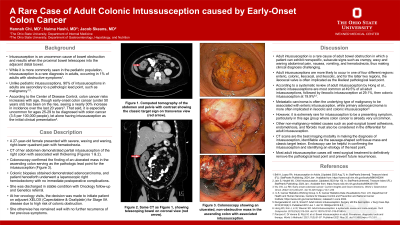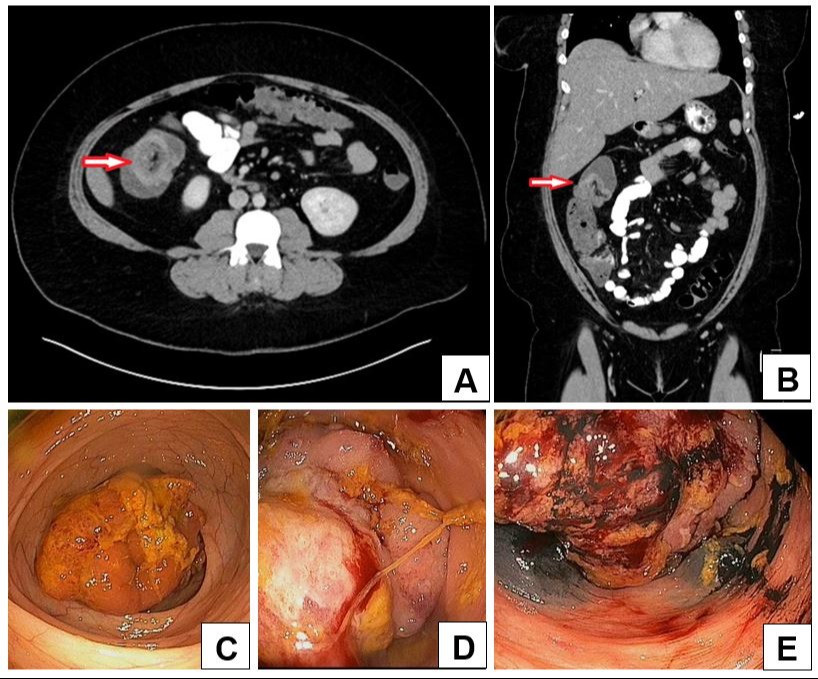Monday Poster Session
Category: Colon
P2089 - A Rare Case of Adult Colonic Intussusception Caused by Colon Cancer
Monday, October 28, 2024
10:30 AM - 4:00 PM ET
Location: Exhibit Hall E

Has Audio

Hannah Chi, MD
The Ohio State University
Columbus, OH
Presenting Author(s)
Hannah Chi, MD, Naima Hashi, MD, Jacob Skeans, MD
The Ohio State University, Columbus, OH
Introduction: Intussusception is an uncommon cause of bowel obstruction and results when the proximal bowel telescopes into the adjacent distal bowel. While it is more commonly seen in the pediatric population, intussusception is a rare diagnosis in adults, occurring in 1% of adults with obstructive symptoms. Unlike pediatric intussusceptions, 90% of intussusceptions in adults are secondary to a pathologic lead point. On account of its rarity, we present a case of a 27-year-old female who was found to have intussusception caused by an ascending colonic mass.
Case Description/Methods: A 27-year-old female presented with severe, waxing and waning right-lower quadrant pain and hematochezia. At the time of presentation, she was being worked up outpatient for endometriosis. CT of her abdomen demonstrated partial intussusception of the right colon with associated wall thickening. Colonoscopy confirmed the finding of an ulcerated mass in the ascending colon serving as the pathologic lead point for the intussusception. Colonic biopsies obtained demonstrated Stage IIA adenocarcinoma, and the patient underwent a laparoscopic right hemicolectomy. She was discharged in stable condition with Oncology follow-up and Genetics referral. At her oncology visits, she was initiated on adjuvant XELOX (Capecitabine & Oxaliplatin). She otherwise has remained well with no further recurrence of her previous symptoms.
Discussion: Adult intussusception is a rare cause of adult bowel obstruction but should be on the differential as it can have disastrous consequences if untreated. In the pediatric population, the etiologies for intussusception are less understood, but lymphoid hyperplasia from inflammation or infections must be considered more highly in this population. In adults, 90% of intussusceptions have pathologic lead points, malignancy making up more than 65% of cases. Other causes in adults include post-surgical bowel adhesions, endometriosis, or fibroids. CT scans are the best imaging modality in making the diagnosis of intussusception, identifiable via the classic target lesion. Endoscopy can be helpful in confirming the intussusception and identifying an etiology of the lead point. Ultimately, most cases will need surgical treatment.

Disclosures:
Hannah Chi, MD, Naima Hashi, MD, Jacob Skeans, MD. P2089 - A Rare Case of Adult Colonic Intussusception Caused by Colon Cancer, ACG 2024 Annual Scientific Meeting Abstracts. Philadelphia, PA: American College of Gastroenterology.
The Ohio State University, Columbus, OH
Introduction: Intussusception is an uncommon cause of bowel obstruction and results when the proximal bowel telescopes into the adjacent distal bowel. While it is more commonly seen in the pediatric population, intussusception is a rare diagnosis in adults, occurring in 1% of adults with obstructive symptoms. Unlike pediatric intussusceptions, 90% of intussusceptions in adults are secondary to a pathologic lead point. On account of its rarity, we present a case of a 27-year-old female who was found to have intussusception caused by an ascending colonic mass.
Case Description/Methods: A 27-year-old female presented with severe, waxing and waning right-lower quadrant pain and hematochezia. At the time of presentation, she was being worked up outpatient for endometriosis. CT of her abdomen demonstrated partial intussusception of the right colon with associated wall thickening. Colonoscopy confirmed the finding of an ulcerated mass in the ascending colon serving as the pathologic lead point for the intussusception. Colonic biopsies obtained demonstrated Stage IIA adenocarcinoma, and the patient underwent a laparoscopic right hemicolectomy. She was discharged in stable condition with Oncology follow-up and Genetics referral. At her oncology visits, she was initiated on adjuvant XELOX (Capecitabine & Oxaliplatin). She otherwise has remained well with no further recurrence of her previous symptoms.
Discussion: Adult intussusception is a rare cause of adult bowel obstruction but should be on the differential as it can have disastrous consequences if untreated. In the pediatric population, the etiologies for intussusception are less understood, but lymphoid hyperplasia from inflammation or infections must be considered more highly in this population. In adults, 90% of intussusceptions have pathologic lead points, malignancy making up more than 65% of cases. Other causes in adults include post-surgical bowel adhesions, endometriosis, or fibroids. CT scans are the best imaging modality in making the diagnosis of intussusception, identifiable via the classic target lesion. Endoscopy can be helpful in confirming the intussusception and identifying an etiology of the lead point. Ultimately, most cases will need surgical treatment.

Figure: Figures A & B. Computed tomography of the abdomen and pelvis with contrast showing the classic target sign on transverse view [Figure A] and telescoping bowel on coronal view [Figure B] (red arrows).
Figure C, D, & E. Colonoscopy showing an ulcerated, non-obstructive mass in the ascending colon with associated intussusception.
Figure C, D, & E. Colonoscopy showing an ulcerated, non-obstructive mass in the ascending colon with associated intussusception.
Disclosures:
Hannah Chi indicated no relevant financial relationships.
Naima Hashi indicated no relevant financial relationships.
Jacob Skeans indicated no relevant financial relationships.
Hannah Chi, MD, Naima Hashi, MD, Jacob Skeans, MD. P2089 - A Rare Case of Adult Colonic Intussusception Caused by Colon Cancer, ACG 2024 Annual Scientific Meeting Abstracts. Philadelphia, PA: American College of Gastroenterology.
